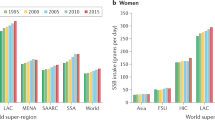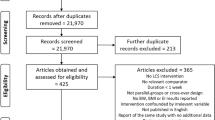Abstract
Over the second half of the last century, soft drinks and other sugar-sweetened beverages (SSB) have assumed an increasingly significant proportion of total energy intake in the US and most ‘westernized’ populations. These beverages are heavily marketed to youth and adults. As such, obesity researchers and public health activists and officials have targeted SSB as one of the primary culprits in the escalating rates of obesity. The purpose of this review is to summarize the evidence from human studies on the topic of SSB and body weight regulation, including a brief review of the purported physiological mechanisms, nutritional surveillance and ecological studies, and a more extensive review of the cross-sectional, prospective and experimental studies in humans to date. The equivocal evidence on this topic makes it difficult to draw firm conclusions regarding the role of SSB in the etiology of obesity. Many of the prospective and experimental studies are of unsatisfactory methodological rigor. Some have drawn analogies between the fight against the food industry and the fight against the tobacco industry. However, the complexity of our food supply and of dietary intake behavior, and how diet relates to other behaviors, makes the acquisition of clear and consistent scientific data on the topic of specific dietary factors and obesity risk especially elusive. Only more high-quality randomized trials on this topic will provide the necessary data to more completely evaluate the possible link between changes in SSB intake and obesity risk.
This is a preview of subscription content, access via your institution
Access options
Subscribe to this journal
Receive 12 print issues and online access
$259.00 per year
only $21.58 per issue
Buy this article
- Purchase on Springer Link
- Instant access to full article PDF
Prices may be subject to local taxes which are calculated during checkout

Similar content being viewed by others
References
Bray GA, Nielsen SJ, Popkin BM . Consumption of high-fructose corn syrup in beverages may play a role in the epidemic of obesity. Am J Clin Nutr 2004; 79: 537–543.
Gross LS, Li L, Ford ES, Liu S . Increased consumption of refined carbohydrates and the epidemic of type 2 diabetes in the United States: an ecologic assessment. Am J Clin Nutr 2004; 79: 774–779.
Harnack L, Stang J, Story M . Soft drink consumption among US children and adolescents: nutritional consequences. J Am Diet Assoc 1999; 99: 436–441.
Popkin BM, Nielsen SJ . The sweetening of the world's diet. Obes Res 2003; 11: 1325–1332.
French SA, Lin BH, Guthrie JF . National trends in soft drink consumption among children and adolescents age 6 to 17 years: prevalence, amounts, and sources, 1977/1978 to 1994/1998. J Am Diet Assoc 2003; 103: 1326–1331.
Yen ST, Lin B-H . Beverage consumption among US children and adolescents: full-information and quasi maximum-likelihood estimation of a censored system. Eur Rev Agric Econ 2002; 29: 85–103.
Bachman CM, Baranowski T, Nicklas TA . Is there an association between sweetened beverages and adiposity? Nutr Rev 2006; 64: 153–174.
Almiron-Roig E, Chen Y, Drewnowski A . Liquid calories and the failure of satiety: how good is the evidence? Obes Rev 2003; 4: 201–212.
Pawlak DB, Ebbeling CB, Ludwig DS . Should obese patients be counselled to follow a low-glycaemic index diet? Yes. Obes Rev 2002; 3: 235–243.
Raben A . Should obese patients be counselled to follow a low-glycaemic index diet? No. Obes Rev 2002; 3: 245–256.
Rolls BJ . The supersizing of America: portion size and the obesity epidemic. Nutr Today 2003; 38: 42–53.
Rolls BJ, Bell EA . Intake of fat and carbohydrate: role of energy density. Eur J Clin Nutr 1999; 53 (Suppl 1): S166–S173.
Troiano RP, Briefel RR, Carroll MD, Bialostosky K . Energy and fat intakes of children and adolescents in the United States: data from the national health and nutrition examination surveys. Am J Clin Nutr 2000; 72 (5 Suppl): 1343S–1353S.
Kant AK, Graubard BI . Predictors of reported consumption of low-nutrient-density foods in a 24-h recall by 8–16 year old US children and adolescents. Appetite 2003; 41: 175–180.
Liebman M, Pelican S, Moore SA, Holmes B, Wardlaw MK, Melcher LM et al. Dietary intake, eating behavior, and physical activity-related determinants of high body mass index in rural communities in Wyoming, Montana, and Idaho. Int J Obes Relat Metab Disord 2003; 27: 684–692.
Nicklas TA, Yang SJ, Baranowski T, Zakeri I, Berenson G . Eating patterns and obesity in children. The Bogalusa Heart Study. Am J Prev Med 2003; 25: 9–16.
Rajeshwari R, Yang SJ, Nicklas TA, Berenson GS . Secular trends in children's sweetened-beverage consumption (1973 to 1994): the Bogalusa Heart Study. J Am Diet Assoc 2005; 105: 208–214.
Giammattei J, Blix G, Marshak HH, Wollitzer AO, Pettitt DJ . Television watching and soft drink consumption: associations with obesity in 11- to 13-year-old schoolchildren. Arch Pediatr Adolesc Med 2003; 157: 882–886.
Ludwig DS, Peterson KE, Gortmaker SL . Relation between consumption of sugar-sweetened drinks and childhood obesity: a prospective, observational analysis. Lancet 2001; 357: 505–508.
Phillips SM, Bandini LG, Naumova EN, Cyr H, Colclough S, Dietz WH et al. Energy-dense snack food intake in adolescence: longitudinal relationship to weight and fatness. Obes Res 2004; 12: 461–472.
Berkey CS, Rockett HR, Field AE, Gillman MW, Colditz GA . Sugar-added beverages and adolescent weight change. Obes Res 2004; 12: 778–788.
Blum JW, Jacobsen DJ, Donnelly JE . Beverage consumption patterns in elementary school aged children across a two-year period. J Am Coll Nutr 2005; 24: 93–98.
Newby PK, Peterson KE, Berkey CS, Leppert J, Willett WC, Colditz GA . Beverage consumption is not associated with changes in weight and body mass index among low-income preschool children in North Dakota. J Am Diet Assoc 2004; 104: 1086–1094.
Welsh JA, Cogswell ME, Rogers S, Rockett H, Mei Z, Grummer-Strawn LM . Overweight among low-income preschool children associated with the consumption of sweet drinks: Missouri, 1999–2002. Pediatrics 2005; 115: e223–e229.
Kimm SY, Glynn NW, Obarzanek E, Kriska AM, Daniels SR, Barton BA et al. Relation between the changes in physical activity and body-mass index during adolescence: a multicentre longitudinal study. Lancet 2005; 366: 301–307.
Striegel-Moore RH, Thompson D, Affenito SG, Franko DL, Obarzanek E, Barton BA et al. Correlates of beverage intake in adolescent girls: the National Heart, Lung, and Blood Institute Growth and Health Study. J Pediatr 2006; 148: 183–187.
Schulze MB, Manson JE, Ludwig DS, Colditz GA, Stampfer MJ, Willett WC et al. Sugar-sweetened beverages, weight gain, and incidence of type 2 diabetes in young and middle-aged women. JAMA 2004; 292: 927–934.
Apovian CM . Sugar-sweetened soft drinks, obesity, and type 2 diabetes. JAMA 2004; 292: 978–979.
Leibel RL, Rosenbaum M, Hirsch J . Changes in energy expenditure resulting from altered body weight. N Engl J Med 1995; 332: 621–628.
Pereira MA, Swain J, Goldfine AB, Rifai N, Ludwig DS . Effects of a low-glycemic load diet on resting energy expenditure and heart disease risk factors during weight loss. JAMA 2004; 292: 2482–2490.
Raben A, Vasilaras TH, Moller AC, Astrup A . Sucrose compared with artificial sweeteners: different effects on ad libitum food intake and body weight after 10 wk of supplementation in overweight subjects. Am J Clin Nutr 2002; 76: 721–729.
Agus MS, Swain JF, Larson CL, Eckert EA, Ludwig DS . Dietary composition and physiologic adaptations to energy restriction. Am J Clin Nutr 2000; 71: 901–907.
Bes-Rastrollo M, Sanchez-Villegas A, Gomez-Gracia E, Martinez JA, Pajares RM, Martinez-Gonzalez MA . Predictors of weight gain in a Mediterranean cohort: the Seguimiento Universidad de Navarra Study 1. Am J Clin Nutr. 2006; 83: 362–370; quiz 394–365.
Newby PK, Muller D, Hallfrisch J, Qiao N, Andres R, Tucker KL . Dietary patterns and changes in body mass index and waist circumference in adults. Am J Clin Nutr 2003; 77: 1417–1425.
Forshee RA, Storey ML, Ginevan ME . A risk analysis model of the relationship between beverage consumption from school vending machines and risk of adolescent overweight. Risk Anal 2005; 25: 1–15.
Tordoff MG, Alleva AM . Effect of drinking soda sweetened with aspartame or high-fructose corn syrup on food intake and body weight. Am J Clin Nutr 1990; 51: 963–969.
DiMeglio DP, Mattes RD . Liquid versus solid carbohydrate: effects on food intake and body weight. Int J Obes Relat Metab Disord 2000; 24: 794–800.
James J, Thomas P, Cavan D, Kerr D . Preventing childhood obesity by reducing consumption of carbonated drinks: cluster randomised controlled trial. BMJ 2004; 328: 1237.
French SA, Hannan PJ, Story M . School soft drink intervention study. BMJ. 2004; 329: E315–E316.
Ebbeling CB, Feldman HA, Osganian SK, Chomitz VR, Ellenbogen SJ, Ludwig DS . Effects of decreasing sugar-sweetened beverage consumption on body weight in adolescents: a randomized, controlled pilot study. Pediatrics. Mar 2006; 117: 673–680.
World Health Organization. Diet, Nutrition, and the Prevention of Chronic Disease. Geneva: World Health Organization and the Food and Agriculture Organization of the United Nations, 2003.
Gidding SS, Dennison BA, Birch LL, Daniels SR, Gillman MW, Lichtenstein AH et al. Dietary recommendations for children and adolescents: a guide for practitioners. Pediatrics 2006; 117: 544–559.
Gidding SS, Dennison BA, Birch LL, Daniels SR, Gilman MW, Lichtenstein AH et al. Dietary recommendations for children and adolescents: a guide for practitioners: consensus statement from the American Heart Association. Circulation 2005; 112: 2061–2075.
Author information
Authors and Affiliations
Corresponding author
Rights and permissions
About this article
Cite this article
Pereira, M. The possible role of sugar-sweetened beverages in obesity etiology: a review of the evidence. Int J Obes 30 (Suppl 3), S28–S36 (2006). https://doi.org/10.1038/sj.ijo.0803489
Published:
Issue Date:
DOI: https://doi.org/10.1038/sj.ijo.0803489
Keywords
This article is cited by
-
Early childhood factors associated with obesity at age 8 in Vietnamese children: The Young Lives Cohort Study
BMC Public Health (2021)
-
Evaluating the effect of energy-dense foods consumption on preschool children’s body mass index: a prospective analysis from 2 to 4 years of age
European Journal of Nutrition (2015)
-
What are Asian-American Youth Consuming? A Systematic Literature Review
Journal of Immigrant and Minority Health (2015)
-
Do sugar-sweetened beverages cause adverse health outcomes in adults? A systematic review protocol
Systematic Reviews (2014)
-
The consumption of unhealthy foods by Brazilian children is influenced by their mother’s educational level
Nutrition Journal (2014)



